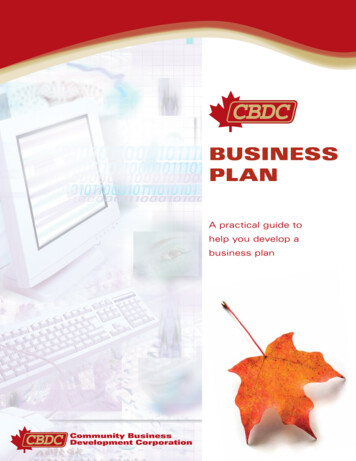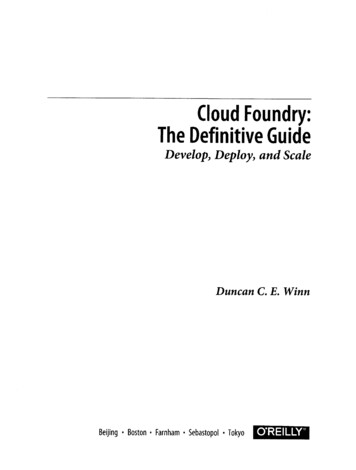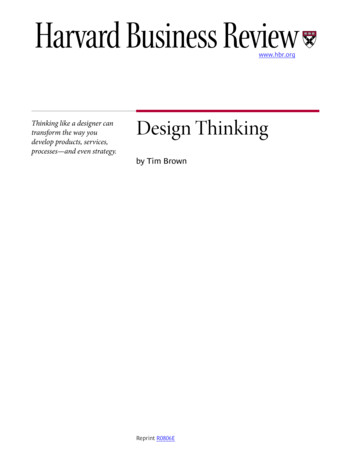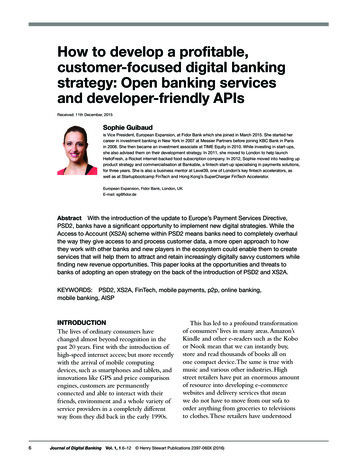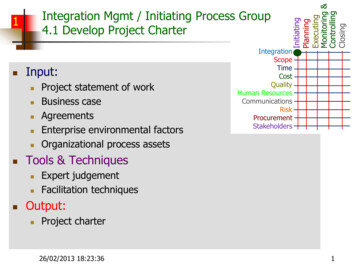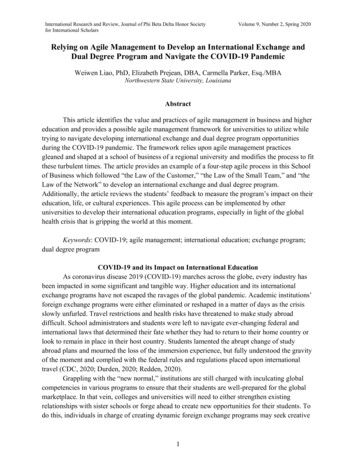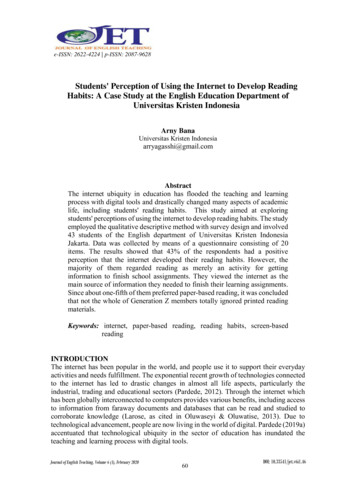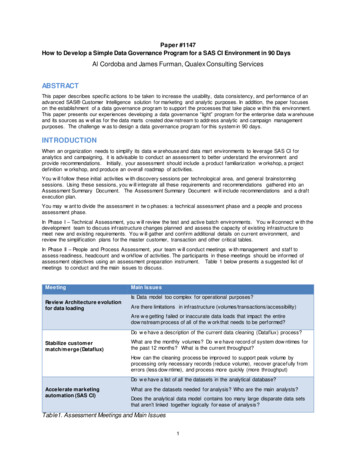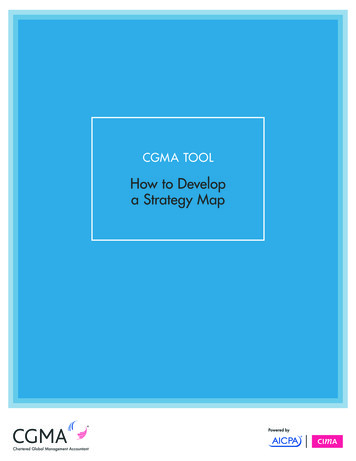
Transcription
CGMA TOOLHow to Developa Strategy Map
contentsTwo of the world’s most prestigious accounting bodies, the AICPAand CIMA, have formed a joint venture to establish the CharteredGlobal Management Accountant (CGMA) designation to elevate theprofession of management accounting. The designation recognisesthe most talented and committed management accountants with thediscipline and skill to drive strong business performance.Introduction2The Strategy Pyramid3Step 1: Specify an Overriding Objective5Step 2: Choose the Value Proposition6Step 3: Choose the Financial Strategies7Step 4: Choosing the Customer Strategies8Step 5: Execute Through the Internal Perspective Strategies9Step 6: Plan the Learning and Growth Strategies10Validating and Cascading the Strategy Map11Conclusion121
IntroductionThe vast majority of organisations have well-defined proceduresfor developing strategic plans. And for the most part, the resultof their planning exercises are good, solid, strategies designedto move the entity forward and provide sustainable, even superior,returns. But there is often a major disconnect between the formulationand execution phases of strategy. The ability to cascade an organisation’svision, mission and core strategies into actionable behavioursthat achieve critical objectives continues to be a challenge formost organisations.As the saying goes, “a picture is worth a thousand words.” Strategymaps, pioneered by Balanced Scorecard founders Robert Kaplanand David Norton, allow organisations to describe and communicatetheir strategies concisely and succinctly and close the gap betweenformulation and successful implementation of strategy. Strategymaps describe how organisations create value by building on strategicthemes such as “growth” or “productivity.” These themes determinewhat specific strategies organisations will adopt at their customer,process, and learning and growth levels. Well-constructedmaps describe how the organisation plans to meet its specificcustomer promises through a combination of employee, technologyand business processes that satisfy customer expectationsand meet shareholder demands.2CGMA TOOL – How to Develop a Strategy Map
The Strategy PyramidStrategy maps can be, and often are, used as standalone tools thatorganisations employ to develop, understand and convey their strategicstory. To maximise their value, however, they need to be seen andused as core building blocks in an aligned strategy initiative. Figure 1highlights where the strategy map and Balanced Scorecard fit in theoverall strategic management process.Figure 1: Strategy PyramidMissionWhy We ExistValuesWhat’s Important to UsVisionWhat We Want to BeStrategyOur Game PlanStrategy MapTranslate the StrategyBalanced ScorecardMeasure and FocusTargets and InitiativesWhat We Need to DoPersonal ObjectivesStrategic icient andEffective ProcessesMotivated andPrepared Workforce3
Strategy Mapping – A Six-Step ProcessThis tool provides an integrated view of the developmentof a strategy map. The steps are:1. Specify an overriding objective.2. Choose the value proposition.3. Choose the financial strategies.4. Choose the customer strategies.Steps 1 through 4 of the strategy mapping processaddress the question, “What do we want to accomplish?”Steps 5 and 6 address the question, “How do we planto accomplish our objectives?” The completed genericstrategy map (Figure 2) illustrates how the financial andcustomer-focused goals of the organisation are linkedto the underlying internal processes and learning andgrowth strategies necessary to deliver on those goals.5. Execute through the internal perspective strategies.6. Plan the learning and growth strategies.Figure 2: Generic Strategy MapCompleted Generic Strategy tomerManagementLeadershipMigratedProductivity StrategyAsset UtilisationIncreaseRevenue perCustomerNewInnovation &CommercialisationSupremacyLearning & Growth1) Human Capital(Staff competencies)CGMA TOOL – How to Develop a Strategy MapNew OfferingsReduce Costper 2) Information Capital(Technology infrastructure)Scalability Strategies(eg Web)EffectiveGovernance &ControlPerception;PublicRelations3) Organisation Capital(Climate for action)How we plan to accomplish itInternal4Revenue Growth StrategyWhat we want to accomplishFinancialMaximise Organisational Value
Step 1: Specify an Overriding ObjectiveIn the next few years, what will it take to succeed? This first stepis critical because it links the strategy map to the earlier phaseof creating/reaffirming an organisation’s mission, core valuesand vision. This step must differentiate between what theorganisation truly understands as its overriding objectiveand the strategies it plans to implement.There is considerable confusion on this point.Many mission and vision statements are oftenmistakenly portrayed as the ultimate objectiveto be achieved – satisfied customers, service excellence,best-in-field, market leader, low-cost provider andso on. Indeed, these are critical outcomes and arehighly desired by all organisations. However,for profit-making organisations, the overridingobjective must be economic.There is no question that serving customers effectively,developing new and unique products and achievingmarket dominance are worthy objectives. But in aprofit-making environment, these are all the ingredientsfor success, not success itself. Success is achieved bysignificant revenues and/or cost containment that lead tosuperior economic returns — the overriding objective.The overriding objective should be the first element ofthe strategy map. It should contain a financial target anda time dimension. Examples of an overriding objectivecould be: Increase return on capital employed by 6% withinthree years Increase profit margin from 8 to 12% and net cash flowfrom 500,000 to 750,000 within five years Increase target share price by 20% by next reporting date Increase total shareholder return relative to benchmarkby 10% within two yearsOverriding objectives are the first item to appearon a strategy map.5
Step 2: Choose the Value PropositionThe second step in strategy mapping is to choose the value propositionthat will help the organisation win the market. The idea behind the valueproposition approach is to choose one dominant value proposition,and provide breakthrough customer value in it. For the two propositionsnot chosen, it is imperative not to lead but to compete, at least to somethreshold level. The three value propositions put forth by Treacy andWiersema provide an excellent framework for competingin today’s markets:1. Operational excellence(also referred to as best total cost)2. Product leadership3. Customer intimacy(also referred to as customer solutions)As Table 1 indicates, three images can make anorganisation stand out. Companies focused onoperational excellence will use price as the key driverof the “best deal” image. The next image is the“best product or service.” Companies that decide tocompete here are using the product leadership valueproposition, and will use unique attributes and featuresin their products and services as their main imagedriver. The third and final image is that of the “bestfriend.” Companies that compete in this area followthe customer intimacy value proposition, providingsolutions to their customers.Table 1: The Value PropositionsValuePropositionOperational ExcellenceProduct LeadershipCustomer IntimacyPrimary focus: very lowprices; Image: “Best deal”High end of pricingHigh end of pricingUnique attributesMeets thresholdstandardsPrimary focus: veryunique attributes;Image: “Best product/service”Meets thresholdstandardsRelationship levelLow end of thresholdstandardsMeets thresholdstandardsPrimary focus: very highcustomer intimacy;Image: “Best friend”ExternalImagePrice6CGMA TOOL – How to Develop a Strategy Map
Step 3: Choose the Financial StrategiesHaving established the value proposition, organisations next formalisetheir plans and strategies around revenues and costs. Financialstrategies can be categorised into three key areas:1. Revenue growth2. Productivity3. Asset utilisationAll organisations must pay some level of attention toeach of these strategies. However, the choice of valueproposition in Step 2 helps dictate which of the threewill dominate and where to spend most of the effort andactivity. Table 2 below indicates the types of financialstrategies companies pursue based on the choice of valueproposition. By aligning financial strategies with thevalue proposition, companies can position themselves toproperly decide what customers are willing to purchase.Knowledge of the value proposition assistsorganisations to pinpoint which of the threefinancial strategies will dominate. Table 2 illustratesthat organisations pursuing operational efficiencypropositions will focus on reaching their overridingobjectives primarily through productivity andasset utilisation strategies. Organisations followingcustomer-intimate or product leadership propositionswill put less focus on these efficiency strategies, insteadattempting to grow revenue through unique productor customer features.Table 2: Financial Strategy ChartFinancialStrategyValuePropositionRevenue GrowthProductivityAsset utilisationOperational ExcellenceProduct LeadershipCustomer IntimacyCompetitive pricesPremium pricingBundlingVolumeNew featuresCross-sellingTight variable anddiscretionary cost controlControl but also spendon R&D and marketingControl but also spendon solution sellingUtilise fixed assetsin pursuit ofproduct leadershipUtilise fixed assetsin pursuit ofcustomer intimacyMaximise inventoryturnoverUtilise fixed assets toreduce product cost7
Step 4: Choosing the Customer StrategiesHaving established financial strategies, organisations must formalisetheir plans and strategies to win the marketplace. In other words, theymust clearly establish and articulate their customer strategies. Customerstrategies can be categorised into three key areas:1. Retaining and adding customers2. Increasing revenue per customer3. Reducing cost per customerOrganisations must pay attention to each of thesestrategies. However, the choice of value proposition onceagain dictates where the firm should focus its effort andactivity. Table 3 indicates the types of customer-focusedstrategies companies tend to pursue based on the valueproposition chosen.Those pursuing operational excellence will usecompetitive prices to retain and add customers,in addition to increasing revenue per customer. Tightprocess and supply chain management will assist in itsongoing efforts to reduce costs per customer. Productleaders will offer the latest of technologies and features,including “add-on” products and services, to increasecustomer volume and revenue per customer. To retainand add customers, customer-intimate companieswill tend to use strategies such as promotingword-of-mouth marketing and loyalty programmes.By offering complete solutions and bundling packages,these companies attempt to increase revenue per customer.Table 3: Customer Strategy ChartCustomerStrategyValuePropositionRetain and addcustomers8Operational ExcellenceCompetitive pricesProduct LeadershipCustomer IntimacyLatest technologiesLoyalty programsNewest featuresWord-of-mouthNew featuresIncrease revenue percustomerCompetitive pricesReduce cost per customerTight process and supplychain managementCGMA TOOL – How to Develop a Strategy MapSolution selling“Add-on” products andservicesBundlingSpending and costcontrol policies in pursuitof product leadershipSpending and costcontrol policies in pursuitof customer intimacy
Step 5: Execute Through the InternalPerspective StrategiesHaving established financial and customer strategies, organisations nextestablish those important actions that will realise the plans and strategiesto win the marketplace. On the right hand side of the strategy map, thefocus changes from “What do we want to accomplish?” to “How weplan to accomplish it.” In other words, the firm must execute the storythat has been developed and revealed in Steps 1–4.The internal perspective is all about choosing andexecuting the right business processes to achievethe desired customer and financial strategies theorganisation believes will lead to the accomplishmentof the overriding objective. Consequently, organisationsmust consciously choose internal business processes thatlink directly to the earlier steps. Table 4 below indicateshow a company could focus its processes, given itsvalue proposition.To endure, all organisations must have solid internaloperations. However, companies following anoperational excellence value proposition must makeinternal operations a very high priority, eliminatingnon-value-adding activities, reducing cost, anddelivering low prices. Organisations pursuing productleadership must mainly focus on processes thatmotivate, identify, develop and launch commercialinnovations because the leadership proposition is tobring cutting-edge technologies, designs or servicesfirst to market. Customer-intimate organisationstend to focus on those processes most closely linkedto customer management: selection, acquisition,preservation and growth. The focus here is ondeveloping knowledge of customers and buildingstrong relationships.Table 4: Key Process ChartProcessto exceland lead atValuePropositionOperational ExcellenceProduct LeadershipCustomer IntimacyInternal operationsPrimary focus—must excelMeets or maintainsthreshold standardsMeets or maintainsthreshold standardsInnovationLow end of thresholdstandardsPrimary focus—must excelMeets or maintainsthreshold standardsCustomer managementMeets or maintainsthreshold standardsMeets or maintainsthreshold standardsPrimary focus—must excel9
Step 6: Plan the Learning and GrowthStrategiesHaving established financial and customer strategies and developedan execution plan, organisations w
How we plan to accomplish it Customer Internal Learning & Growth Solutions Focus Completed Generic Strategy Map Asset Utilisation Figure 2: Generic Strategy Map This tool provides an integrated view of the development of a strategy map. The steps are: 1. Specify an overriding objective. 2. Choose the value proposition. 3. Choose the financial strategies. 4. Choose the customer strategies.

